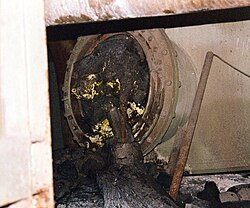Chemistry:Chernobylite
From HandWiki
Short description: Technogenic mineral

Chernobylite is a technogenic compound, a crystalline zirconium silicate with a high (up to 10%) content of uranium as a solid solution.
It was discovered in the corium produced in the Chernobyl disaster, a lava-like glassy material formed in the nuclear meltdown of reactor core 4.[1][2][3] Chernobylite is highly radioactive due to its high uranium content and contamination by fission products.
See also
- Trinitite
- Elephant's foot
References
- ↑ United States. Joint Publications Research Service; United States. Foreign Broadcast Information Service (1991). USSR report: Chemistry. Joint Publications Research Service.. https://books.google.com/books?id=y6c9AAAAMAAJ. Retrieved 20 July 2012.
- ↑ Richard Francis Mould (1 May 2000). Chernobyl Record: The Definitive History of the Chernobyl Catastrophe. CRC Press. pp. 128–. ISBN 978-0-7503-0670-6. https://books.google.com/books?id=O36UC03ODtcC&pg=PA128. Retrieved 20 July 2012.
- ↑ Valeriy Soyfer "Chernobylite: Technogenic Mineral", Khimiya i Zhizn', No 11, Nov. 1990, p. 12, in Science & Technology USSR: Chemistry. JPRS Report. 27 March 1991. p. 29.
External links
 |
